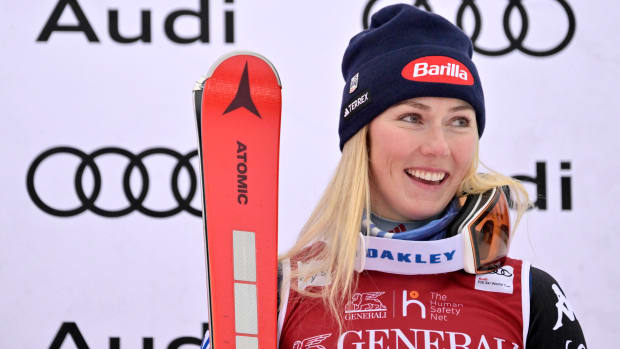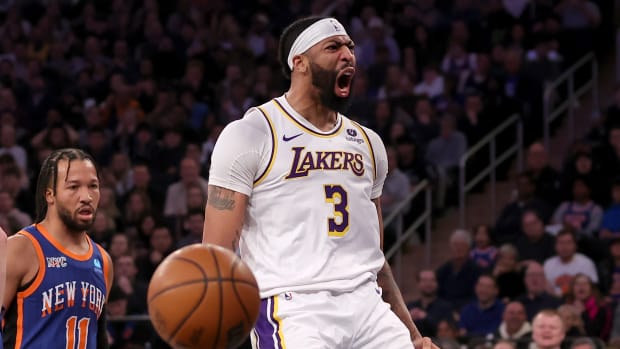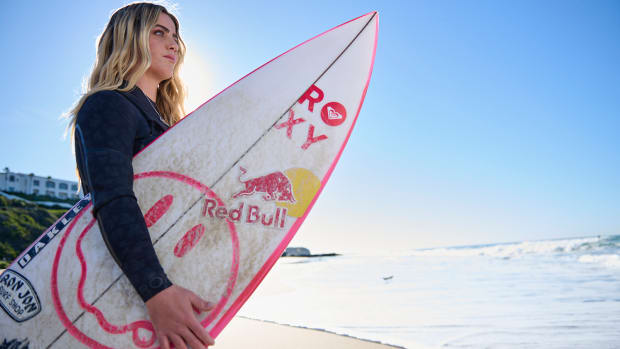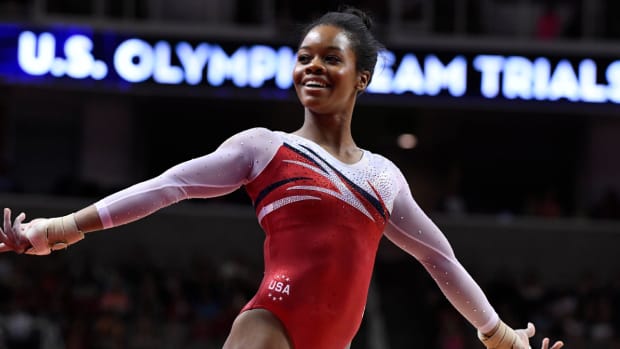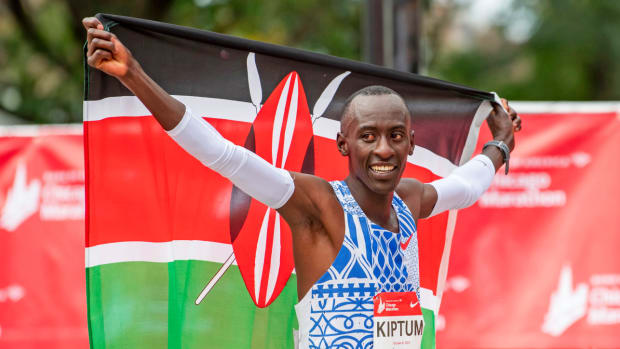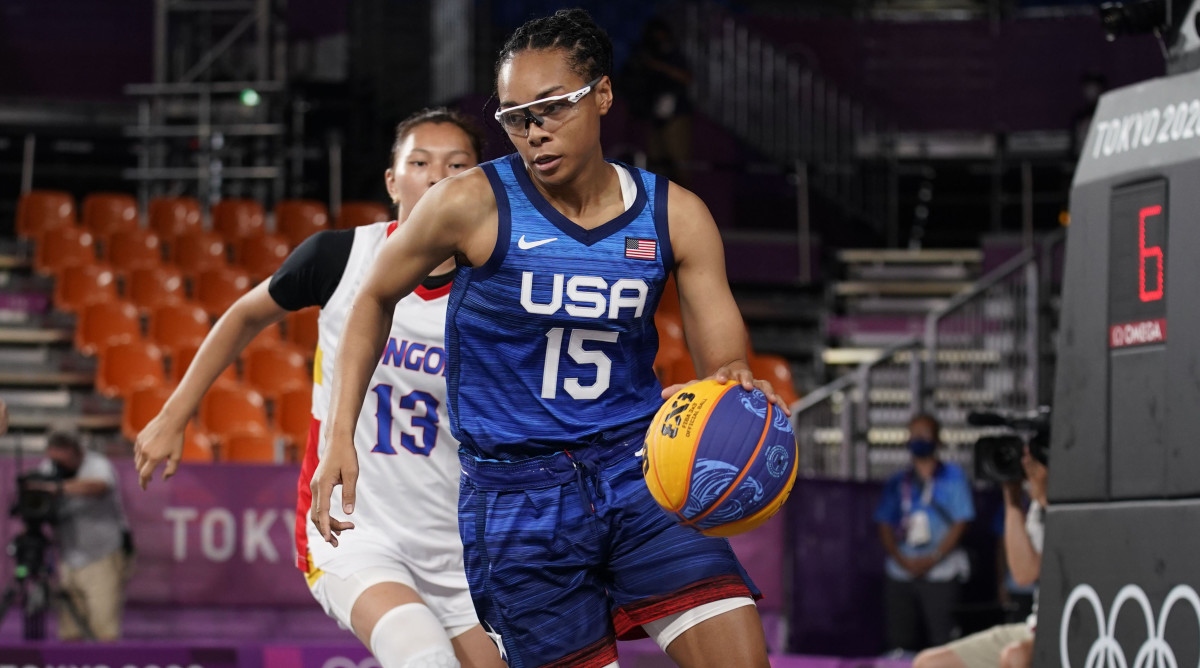
Team USA's Dominant 3x3 Basketball Debut at the Olympics Was Quite the Spectacle
Very Olympic Today is SI’s daily Olympics newsletter. You can receive each issue for free in your inbox by subscribing here. To continue reading the newsletter at SI.com every day, along with the rest of our Olympics coverage, readers can subscribe to SI.com here.
TOKYO — This actually happened. This strange, dizzying, normalizing, futuristic, kaleidoscope-y day in Olympic, pandemic and U.S. history. Don’t laugh! It’s true. This spectacle that took place on half a basketball court, in front of more cameras than spectators, with neon lights flashing in the distance, hip-hop blaring over speakers and clouds threatening a downpour overhead, on the still-in-a-public-state-of-emergency island of Japan.
Skyscrapers loomed in the distance, in view of the President of France and the First Lady of the United States. Their seats were orange, the volunteer T-shirts nearby blue, the covers white, the signage purple, the court itself gray, until the first three-on-three basketball games ever played in the Olympics flipped off rather than tipped off. (Using, of course, a coin.)
There was a Big Mama Stef (Stefanie Dolson) playing for the United States. There was a women’s team from Mongolia. There were Americans with roots in other countries hooping for those teams (like former Gonzaga Bulldog, Ira Brown). There was a DJ playing music known as LOST, which is how it felt to sit here, immersed in something no one, not even the highest person in the world, ever thought they’d see until recently.
Planes cruised by overhead. Cameras zipped above the action on makeshift tracks. An informal fan count landed at seven, as in humans, give or take. The referees wore untucked mesh shirts covered in sweat, like YMCA dads. The speakers pinged like Super Mario Bros. every time a shot dropped. The world’s most excitable announcer screamed and screamed and screamed. “Bang! Bang! Excitement! Excitement!”
Why do this? Kelsey Plum, star of the favored U.S. women’s team, shrugged here on Saturday evening. She had a better question. “Why not?”
Plum had stood there, just before 5:58 p.m., glanced right and … was that Jill Biden? Indeed. Plum waved. Why not? The affair flipped off at 5:58 p.m. in Tokyo, the first three-on-three basketball contest for an American team in the Olympics, and she noticed the First Lady cheering, bringing “all the energy,” more like the First Fan of 3x3.
The game itself looks like regular basketball, mostly, except it’s more like basketball/pinball, only with six human pinballs pinging around the court. It’s often framed as relatable to everyman (or woman) hoopers, the teenaged and middle-aged, the backyard champs and driveway stars. This is not that. It’s the opposite of the games that sports writers play at the Final Four, in that it’s athletic, sped up and physical—basketball chaos, more or less. “It’s got a street vibe to it,” Plum says. “It’s like pandemonium, like you’re shot out of a cannon.”
The sport’s format—it’s pronounced three-x-three, not three-on-three; there are differences in set-up—works like this: games last 10 minutes; they’re played on courts that are confined to 49-feet-by-36-feet; shots hoisted behind the 3-point line count for two points, shots inside count as one; the shot clock expires after 12 seconds; teams consist of four players and one coach who, like in tennis, cannot instruct during competitions; players shoot one foul shot per whistle, rather than two, and cannot foul out, raising the physicality of the play; and the first team to 21 wins, unless neither team hits that number, in which case the highest total does.
That might sound boring, the technical explanation. It’s not. These rule tweaks also change points of strategic emphasis. Defensive liability 3x3ers, for instance, cannot rely on towering centers to block the shots of players who blew past them; nor summon help on stars. There are fewer specialists in the half-court game, because the action is endless, there’s nowhere to hide and versatility is not simply welcomed but necessary. “The game has its own methodology, its own approach, its own style of player. It’s not just, roll the ball out and win,” says Matt Santangelo, a member of Gonzaga’s 1999 Cinderella team who’s now the executive director of the Spokane Hoopfest Association. To prove his point, he points to the U.S. men’s national team that failed to qualify, despite a deep pool of talent that’s not trained for three-on-three specifically. It’s not enough to simply show up and flash talent.
Hoopfest, for the uninitiated, started in 1990 in Spokane. It wasn’t the first three-on-three tournament in the U.S., but it quickly grew into the largest, at one point hosting over 7,000 teams, the pool grown from the 512 that played in Year 1. The creators set some rules: the event had to take place downtown, not on some faraway fairgrounds, or the parking lot of a local arena. They wanted to shut down traffic and make Hoopfest an event. That happened. Santangelo could not compete in the tournament while at Gonzaga, but he still packed into downtown, where the population of the city almost doubled every tournament.
By the time he started working for the organization, in ’14, Santangelo came to understand that Olympic 3x3 had already been discussed by the International Basketball Federation. FIBA had actually agreed on uniform 3x3 rules seven years earlier, even going so far as to test out the sport at the Asian Games (also ’07), the Youth Olympics (‘10) and the World Cup (’12).
By ’17, it became official, the Olympics, if not universally beloved by the purists who wanted FIBA to get off their lawns while “real sports” continued to ascend to this abstract ideal, the implication being that shooting arrows, sweeping objects as they glide down ice and riding mountain bikes were all totally normal and legit. (Not to mention previous endeavors, all eventually canceled, like pistol dueling, pigeon shooting and horse long jump.)
The Games were making a push, anyway, to appeal to younger audiences and three on three fit that ethos, just like skateboarding, BMX and surfing. All of those pursuits are atypical, in the “Olympic” sense. So is diving into the water from the ceiling intending to make the smallest possible splash. When the IOC commissioned a study ahead of Tokyo 2020, three-on-three basketball ranked as the urban team sport played most widely in not just the U.S. but the world.
As Plum noted, it’s not like there’s one huge national team pool and some of the women who don’t make the typical U.S. national team get shoved into three on three and can triumph simply by showing up. Instead, the players—Plum, Dolson, Allisha Gray and Jackie Young, who replaced Katie Lou Samuelson just before everyone flew to Tokyo after Samuelson tested positive for COVID-19—trained for years, tweaking regimens, like increasing cardio for the all-out sprints, for this event. They went 6-0 in Olympic qualifying.
There are more three-on-three basketball events in the U.S. than ever, like The Big Three, founded in part by the entertainer Ice Cube. There’s a traveling Red Bull tour that plays 3X, with the shot clock and no resets beyond the changing possessions. Like don’t check the ball. Don’t wait to run isolation play after isolation play. Just grab the board, rush to the arc and then head right back in. “And, frankly, USA Basketball is way behind, which is an opportunity,” Santangelo says. Meaning, because they haven’t emphasized the sport, or FIBA’s ranking systems. Or developed feeder systems. Not yet.
Santangelo believes that’s coming, an even bigger boom, an Olympic sport, strange and hallucinogenic as it may be, poised for a longer run than the purists might anticipate. On Saturday in Tokyo, the U.S. women won their first game, over France, 17-10; then their second, held only a few hours later against Mongolia, 21-9. The French president, Emmanuel Macron, laughed as he told a scrum of reporters, “Come on, come on, come on. They defeated us. It was sufficiently painful.”
There were some odd statistics. This, after all, is 3x3, a sport where they count drives (DRV), buzzer-beaters (BZR) and something called Highlights (which should be WTF but are actually HGL). But that oddness, the way that the sport can resemble both an alternate universe and something that’s backyard-growing up familiar, could help sustain it. It’s a good way to teach the game, because of the varied skills required and the limited bench space. “There’s only one Dream Team, right?” Santangelo says. “But how do these millions of other people who love to play basketball get to dream about the Olympics? Now, they can. This is an accessible sport.”
After the buzzer signified the end of the first U.S. win in Olympic 3x3 history, the players ran up toward the stands where the First Lady sat. They thanked her, asked her to come back.
She said she hoped she could.
Why not?
More Olympics Coverage:
• The Games Go On—With a New Purpose
• Meet Team USA Athletes Competing in Tokyo
• Katie Ledecky Is Hungry For Even More in Tokyo


